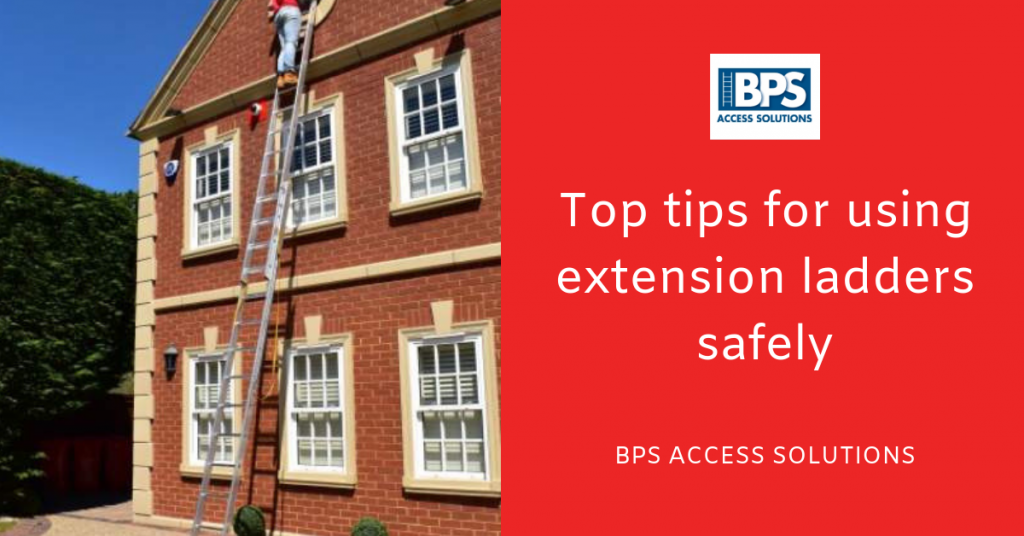Being safe whilst using ladders is a matter that must be taken very seriously, as one wrong move or bad decision could be devasting. Below are some straightforward steps you should always take when handling and climbing extension ladders, to maximise the effectiveness of the ladder, and most importantly provide safety to the user. Thus ensuring that when you use ladders, especially with extensions that you do so in an efficient way, getting the task in hand completed without complications.
Be prepared
When using ladders be ready both with the correct safety attire, such as suitable shoes etc, and have at least one other person on hand to provide the additional support you will need. Be aware of the type of ladder you will be using, what its capabilities are and how it is set up, as well as what its limitations are. Try to avoid using ladders in bad weather as this is an additional hazard that is best avoided, so your best bet is to check the weather forecast to try and opt for a day without rain. Do these things before climbing because when you’re high up the ladder it could be too late.
Flat base
The base of the ladder and what it rests on is pivotal to the ladder being safe to use, so it may be necessary to dig a small trench that the ladder can sit in to provide additional safety. This may take a bit of time, but it is well worth it in order to guarantee a sound base, although it may also be worth your while if you’re on the grass to acquire a grass gripper that can also be used on decking. However, this may not be possible with some ground conditions, so instead, you should opt for adjustable leg levelling attachments that you can use for the same purpose such as a levelling mat. You can find all of these accessories on our ladder accessories page.
Be sure
When ready to climb, make sure that the ladder is at the correct angle to climb. You must place the ladder against the structure you want to climb at a sufficient angle, which is usually a quarter of the ladders full length. Take a moment to check that the angle is correct by placing your feet against the foot of the ladder and stretching out your arms fully, you should be able to grip a rung if the ladder at a safe angle. Next, make sure that the feet of the ladder is secure, and that the extending section you are using is secured by the rug locks. Also, check that the person or persons that are on hand to support you are ready to hold the ladder still.
Climb carefully
When climbing ladders, always climb one rung at a time, take your time and step cautiously. Always use both hands to hold on to the ladder when climbing and be aware of the area around you and remain vigilant for any potential hazards. When you reach the top, it is strongly advised that you have some form of additional support to secure the upper section of the ladder to the structure it is resting on. This is to provide similar support to that on the base of the ladder, in terms of securing the ladder. This could be a ladder stabilizer attached to the ladder or another form of safety measure.
Keep a level head
Don’t take unnecessary risks while on ladders, especially leaning and stretching beyond the specified distance. You’ll want to refrain from leaning and stretching as much as possible as movement on ladders, particularity away from them, could cause significant imbalance and put yourself and potently others at risk. If you need to complete work that is out of your reach, then it is necessary to move the ladder to a closer position to complete such work or consider a scaffold tower. You need to Remember to descend the ladder as carefully as you climbed it, because it’s just as dangerous if not more so as you may be tempted to hurry down or be less careful.
Hands free
If you require tools whilst up the ladder, then you should use a tools belt that can be tied around your waist, yet remain accessible with what you need for the job in hand. Remember both your hands are required when climbing up and down the ladder to be sure of your balance and safely while on the ladder. If the ladder or you slip having both hands ready to grip the rungs firmly could save your life. You may also want to consider suitable gloves in order to reinforce extra grip and help to protect your hands.
Vertical only
Never use a ladder horizontally, it is not designed for such use and will be extremely unsafe to use for any purpose. Read and follow the instructions issued for the ladders use, from the manufactures. The safety features will be unable to support the ladder meaning that the risk is increased massively. Only use ladders as you are instructed to use them, any deviation from the instructions will increase the chances of accident and injury. Ladders purchased from BPS Access Solutions will contain the instructions when purchased The instructions will be alongside the ladder when purchased and should be read and retained for future use.
Keep clear
Ensure that the areas around the base and top of the ladder are clear. Objects and obstructions in those spaces could be a threat to the ladders stability and your ability to move off and on the ladder safely. If the ladder is damaged do not attempt to use and make it clear to others that the ladder is defective and must not be used. You should aim to resolve the fault quickly to reduce the potential risk of unsafe equipment being accessible and posing a risk to others. This could be costly but is necessary to keep possible users safe.
Following these tips should ensure that you and others are as safe as possible while handling and climbing extendable ladders in the future. If you would like any future information or are interested in purchasing an extension ladder, then contact BPS Access Solutions.
No related posts.



